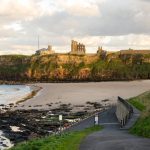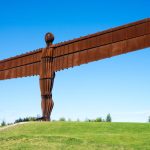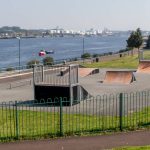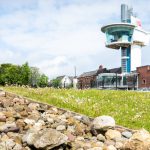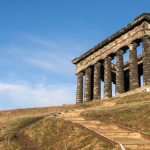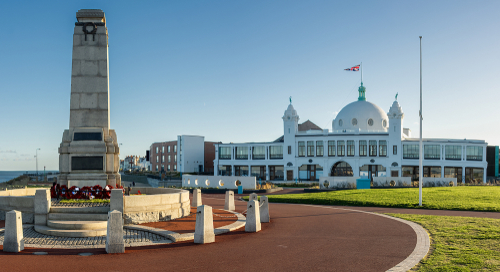
Whitley Bay is a coastal town on the north-east coast of England. It is administered as part of the borough of North Tyneside in the region of Tyne & Wear. The town is situated about 10 miles north-east of Newcastle and just over 3 miles north of North Shields. The seaside town is particularly popular as both a day-trip destination and nightlife centre for the populace of Tyne and Wear. The population of Whitley Bay in the 2011 UK Census was recorded as 9,416.
Whitley Bay – A Fleeting History
The origins of the name Whitley can be traced back to its establishment around 1116 when it was a tiny hamlet owned by the Prior of Tynemouth. One of the first tenants of the Priory was the ‘de Whitley’ family. They took up residence at a manor house on the tenanted land and the ‘Whitley’ name can obviously be attributed back to them. The de Whitley family were far from ideal tenants, as their relationships with the Priory and local nobility, ran far from smoothly over the course of their tenure, which was to last more than 200 years. Spats between the parties down the years involved incidents and accusations of theft, burglary, kidnapping and arson, amongst other charges.
In 1345, Gilbert De Whitley got royal approval to fortify his residence at Whitley, most likely as a response to the perceived growing threat from an invasion by the Scots. However, sometime early in the second half of the 14th century, the de Whitley family’s tenure at the seat of power in Whitley came to an end, as they failed to produce a male heir. There was a succession of tenants at the manor house over the next five decades but in 1404 the residency was reclaimed by Tynemouth Priory.
It remained in the hands of the priory up until 1539 when the Act for the Dissolution of Monasteries by Henry VIII, was enforced. Whitley then fell under the jurisdiction of the crown until 1551, when Edward VI bestowed the majority of the land around Whitley to the Earl of Warwick. The Earl went on to become the first Duke of Northumberland and the ownership of much of Whitley’s land by the Duke’s descendant was to endure. The present Duke of Northumberland is still the Lord of the Manor and principal landowner around Whitley.
Coal Mining Takes Off
While coal mining had been carried out around Whitley Bay on an ad hoc basis since Anglo-Saxon times, in the 1660s, local entrepreneur Henry Hudson, began to develop the local industry. The Hudson family local business interests went on to include salt production, lead mining and limestone quarrying. In 1760, a descendant, also Henry Hudson, a local landowner, built Whitley Hall.
In 1789, another stately home, Whitley Park, was built by a local gentleman farmer, Edward Hall. During the early part of the 20th century, the former manor house served as a hotel. Today, Whitley Park the house, no longer exists, but the grounds are still called Whitley Park and are now a public park.
In April 1810, a shaft was sunk at Whitley Colliery, expanding the workings of those initiated by Henry Hudson. The coal was predominately used to fuel lime kilns in the nearby Marsden quarry. The pit, located at the site of today’s Metro Station, closed in 1880, due to its unprofitability. However, during the 19th century Whitley greatly expanded to accommodate an influx of colliers and other workers.
Starting To Grow
By the 1860s Whitley was still a relatively small village, consisting of little more than a single short street. The extent of the main street was between the junctions with North Parade and South Parade. It wasn’t until 1864 that Whitley had a church when St Paul’s church was built at the west end of the village. Funds for the building of the church were provided by the Duke of Northumberland. At this time, both the neighbouring villages of Monkseaton and Cullercoats were larger than Whitley, and nearby North Shields was by now a thriving port town.
In 1873, the Whitley and Monkseaton Local Board was established, which then became the Urban District of Whitley and Monkseaton. At this time, land in the town was being snapped up for development. Many of the shops, large townhouses and hotels standing on the town’s seafront, were constructed during this period. In 1882, the opening of the North Eastern Railway’s new coastal line proved to be the catalyst for the further rapid growth of Whitley, as both a seaside resort and a commuter town. By 1898, North Parade, South Parade, Station Road and The Esplanade had all been constructed.
What’s In A Name
Up until 1902, the town was known as Whitley or sometimes as Whitley-by-the-Sea. However, the town’s designation was often confused with that of Whitby, North Yorkshire, regularly causing misdirection of mail. Folklore has it that in September 1901, a former resident’s body was mistakenly transported to Whitby, instead of Whitley, causing a delay in the funeral proceedings. It was considered the final straw, obliging the council to seek a name change. A poll of local residents was undertaken in the search for a new town name. The most popular choice arising from the survey was the name ‘Whitley Bay’.
During the early part of the 20th century, Whitley Bay continued to expand rapidly, with the town’s promenades being built during the period. In 1910, the Spanish City and Whitley Bay Pleasure Gardens’ was opened at Whitley Park. The name ‘Spanish City’ was adopted from the nickname given by locals to a temporary exhibition and show with a Spanish flavour put on by Edwardian showman Charles Elderton. The domed Spanish City went on to become Whitley Bay’s most iconic landmark.
With the continuing development of Whitley Bay, the neighbouring village of Monkseaton was eventually absorbed in the town’s development, becoming a suburb. On 1 January 1944, the Whitley and Monkseaton Urban District became the Whitley Bay Urban District. By the early post-war years, there was continuous linear development all the way from Tynemouth, through the village of Cullercoats, to Whitley Bay and beyond. In March 1954, the District was granted a Royal Charter of Incorporation, becoming the Borough of Whitley Bay.
Whitley Bay – The Modern Era
In the early post-war years, Whitley Bay provided an easy reach day-trip destination for workers employed in the heavy industries of Tyneside. The customary Scottish holiday fortnight in July also saw masses of Glaswegians heading to Whitley Bay for their time-honoured seaside summer holiday. A tradition that continued up until the early 1970s.
From that time onwards, Whitley Bay along with the rest of the UK’S traditional seaside holiday resorts began to face growing competition from the rise in popularity of the increasingly cheap foreign package holidays. However, Whitley Bay’s close proximity to the heavily populated areas of Tyne and Wear and the quality of its beaches means that it has perhaps fared better with regards to dwindling tourist numbers than most other British seaside resorts through the last 50 years.
In 1972, the Local Government Act abolished the Urban District of Whitley Bay. Hartley in the north of the former Whitley Bay district became part of Blyth Valley district in Northumberland. Whitley Bay, including Monkseaton, became part of the Metropolitan Borough of North Tyneside in the parliamentary constituency of Tynemouth.
The Metro Arrives
In 1980, the Tyne and Wear Metro system went into operation, being officially opened by the Queen a year later. The route of the Metro around Whitley Bay largely follows the line of the old coastal railway. There are Metro stations at both Whitley Bay and Monkseaton. The Metro, like its predecessor, the North Eastern Railway, has provided a cheap and convenient form of transport to Whitley Bay from the rest of the region. This has kept the town popular as both a day-trip destination and nightlife centre for the populace of Tyne and Wear.
The Spanish City
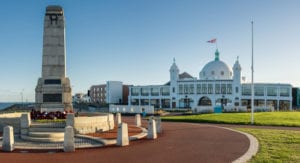
Image John J Brown/Shutterstock.com
For many years, Spanish City was a typical old-fashioned British seaside theme park with rides and attractions. However, following neglect and subsequent decay, it eventually closed down in 2000. In 2007, North Tyneside Council announced plans to regenerate Whitley Bay. At the heart of the plan was the redevelopment of the Spanish City site. In 2018, after extensive renovation work, Spanish City was re-opened to the public.
Whitley Bay’s iconic building was completely restored to its former glory, with its refurbishment being completely faithfully to its original unique design. The building now offers a wide choice of restaurant and leisure facilities, as well as being a venue for weddings and conferences. The re-opening of Spanish City was viewed by many as putting Whitley Bay firmly back on the tourist map.
Getting there!
Road
If you’re travelling by car, then the easiest way to get to Whitley Bay from London and the south, and Edinburgh and the east of Scotland, is via the A1(M)/A1. Just head for Newcastle from the south but turn onto the A194 at Washington, and then on to A19 following the road signs for Jarrow.
After passing Jarrow, turn right on the A1058 Coast Road and head towards Tynemouth. On the outskirts of Tynemouth turn left on to the A192 (Preston Road North) and head north for about a mile to Monkseaton. Turning right at Monkseaton onto Caudwell Lane, it’s a further mile to Whitley Bay.
The A19 brings you north to Whitley Bay from Sunderland, Middlesbrough and most of the Yorkshire area, passing through the Tyne Tunnel at Jarrow.
Rail
There is no mainline train station in Whitley Bay. However, if you want to take the train to Whitley Bay just head for Newcastle. Its train station is one of the busiest in the UK and connects directly to almost all the country’s major destinations. Newcastle’s Central Station is an interchange terminal for the Metro Line (See below). Thus, after arriving in Newcastle you can take the Metro directly to Whitley Bay on the Yellow Line.
The Metro
The Tyneside area is served by the Tyne & Wear Metro, a system of suburban and underground railways covering much of the region. The Metro consists of two lines, the Green Line which originates at Newcastle Airport, passes through the city centre and then reaches Sunderland, terminating at South Hylton. The Yellow Line starts at St James, then runs eastwards north of the river to Whitley Bay, before returning to Newcastle, via North Shields on the coast. The journey time between Newcastle and Whitely Bay is about 25 minutes.
Buses
There are two operators that provide bus services in and around the Whitley Bay and to Newcastle and other nearby towns; Arriva North East and Go North East. Buses leave Newcastle’s Haymarket Bus Station every 15 minutes for Whitley Bay with a journey time of around 40 minutes. Long-distance bus services to and from Whitley Bay linking with the rest of the country is operated by National Express.
Airport
Newcastle International Airport is located on the outskirts of Newcastle at Ponteland, approximately 14 miles (22 km) from Whitley Bay. The airport and Whitley Bay are also connected via the Metro rail system. The expected journey time to/from Whitley Bay to Newcastle Airport via car or taxi would be around 30 minutes and 50 minutes via the Metro. There are numerous short-haul and long-haul flights to multiple destinations throughout Europe, Asia and the Americas from Newcastle Airport.
Places to see in Whitley Bay!
St Mary’s Lighthouse
A prominent local landmark, St Mary’s Lighthouse, is located on St Mary’s Island. The lighthouse itself is now a small museum, and the island, a nature reserve. The island can only be reached by a short causeway which is subject to twice-daily tidal inundation. The lighthouse’s visitor’s centre has several exhibitions on the history of the lighthouse and local wildlife. If heights don’t present a problem, you can climb the 137 steps to the lighthouse’s lantern room, which offers spectacular panoramic views. Suffer a bit of vertigo, then no worries! A live video facility allows you to experience the same views from ground level.
Things to do in Whitley Bay!
South Beach
The town’s South Beach area is typical of an old-style British seaside resort featuring a fairground, paddling pools, boating lakes and mini-golf course. There’s a pretty decent beach and any dangerous swimming areas are well marked. Cullercoats Bay is reputedly the town’s best beach and offers the safest swimming. Sea kayaking and surfing are also popular activities with equipment being locally available for hire. Lifeguard cover is provided from May to September.
Whitley Bay Ice Rink
Whitley Bay Ice Rink is used by thousands of people each week, including the local ice hockey team Whitley Warriors (see above). The rink welcomes all comers, from complete skating novices to budding professionals. There’s a variety of sessions on offer from relaxed family gatherings, to disco, to arduous figure skating training sessions.
Blue Reef Aquarium
Just 3 miles from Whitley Bay in North Shields is the Blue Reef Aquarium. There are over 40 displays of aquatic life from local waters to the more exotic. Amongst the more striking live exhibits are the blacktip reef sharks, which can grow to almost 2 metres in length. There’s also rays and other colourful fish that can be observed as you walk through the ocean tunnel.
Sport
Football
Whitley Bay F.C. is a semi-professional team that play at the town’s 4,500 capacity Hillheads Park, adjacent to the town’s ice rink. Whitley Bay F.C. play in the Northern League Division One, the 6th tier of the English. You can catch a game every other Saturday during the August to April football season.
Ice Hockey
Whitley Bay Ice Rink is home to Whitley Warriors Ice Hockey Club (see below). They play in the third tier of British ice hockey, the National Ice Hockey League North Division 1. The season starts in September and runs through to April, with games generally being played on a Sunday.
Rugby Union
Whitley Bay Rockcliff RFC is the local premier rugby union team. They play at the Lovaine Avenue ground in Hillheads. The club plays in the Durham and Northumberland Division 2.
Where to stay?
A broad indication of prices for the most readily available types of accommodation in Whitley Bay, based on 2 people sharing, are:
Hotel: £60 – £100
Lodge/B & B/Guesthouse: £40 – £60
Take the Whitley Bay Quiz
Now you have read our guide test your knowledge with our quiz!
So there you have it our Five Minute take on Whitley Bay and our quick quiz. Before you go why not try some of our other quizzes or have a look at some of our other location guides. If you have not already, don’t forget to join our growing community we have so much to offer.
